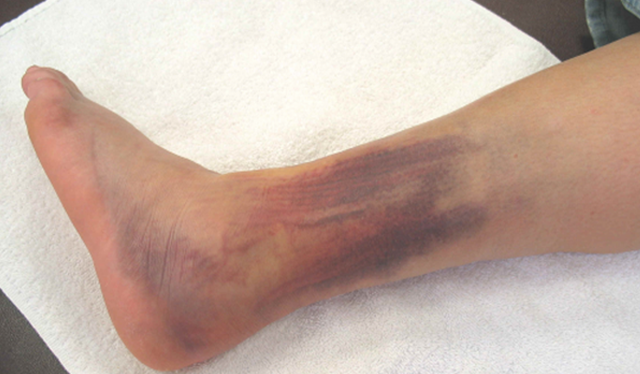Injected poison (stings or bites)
- Remove sting if possible.
When to call the poisons information centre
You can call the "PoisonsInformation Centre" on 13 11 26:
- If you or someone in your care may have been poisoned DO NOT wait for any symptoms to occur before calling 13 11 26
- If a person is bitten or stung by a marine creature, animal, reptile, spider or insect
- If you have any questions or concerns about:
- prevention of poisoning
- hazards associated with drugs, medicines, chemicals, plants, pesticides and any other products
- If in doubt call and check.
Poisons may include:
- Car products
- Cleaning products
- Insecticides, weed killers, rodent and snail baits
- Kerosene, petrol, methylated spirits, etc
- Any over-the-counter medicines
- Paints and thinners
- Perfumes and aftershaves
- Plants and mushrooms
- Prescription medicines
- Many more, so always check
Soft tissue injuries
Soft tissue injuries are those injuries affecting the joints and muscles of injured, but not fractured, limbs. Sprains, strains and dislocations are considered soft tissue injuries, with some authorities also including bruising.
Treating soft tissue injuries is based on resting the injured part, applying ice packs to limit swelling and reduce pain, applying a firm compression bandage as support and elevating the limb. This treatment is known as 'RICE'.
- Rest. The injured part is rested immediately to reduce internal bleeding and swelling and to prevent the injury from becoming worse.
- Ice helps to limit inflammation and reduce pain by causing the blood vessels to constrict, restricting the amount of fluid and swelling in the injured part.
- Compression. Wrapping the injured part with tape or an elastic bandage helps limit swelling by reducing blood flow to the injured part.
- Elevation. Raising the injured part above the heart reduces blood flow to the injured part.
Ice packs should be placed on for 10 minutes and can be re-applied when the damaged area becomes warm again (about 10 minutes).
Never apply ice directly onto the skin, as this may cause tissue damage. Always use a barrier, such as cloth, between the ice pack and the skin, to help protect tissue.
Sprains
Sprains involve the over- extension of a joint, usually with partial rupture of the ligaments. There may also be blood vessel, nerve and tendon damage. An injury with severe ligament damage may require subsequent immobilisation in a plaster cast.
Sign and symptoms
- Sudden pain in the joint
- Loss of power and ability to bear weight
- Bruising
- Swelling
- Site becomes tender, painful to palpate
Care and treatment
- R.I.C.E
- Seek medical aid for assessment of ligament damage
Strains
Strains involve over- stretching of the major muscles or tendons and occur when the fibres of a muscle or tendon are over-stretched and tear. This injury is usually less severe than a sprain, but can still have complications if not managed correctly.
Sign and symptoms
- Pain, increasing on movement
- An audible 'crack' may be heard as the tendon parts from the bone
- May have a discernible gap between muscle and bone
- Tenderness, discomfort when weight bearing
- Swelling, if near joint
Care and treatment
- R.I.C.E
- Avoid stretching or massaging the injured limb for 24 hours
- When the pain subsides, start activity slowly and in moderation
- If pain persists, seek medical aid
Avoid using a strained muscle while it is still painful
Bruising
Bruising or more correctly, 'contusion', is bleeding by damaged blood vessels beneath the surface of the skin. This is invariably caused by blunt trauma, the application of force to the injured site. A common injury especially in contact sports is 'corked thigh', a heavy blow to the muscle mass of the thigh, which involves damage to blood vessels as well as injury to the thigh muscle tissue. Although not a serious injury, it is very painful and prompt first aid assists in a rapid recovery.
 Sign and symptoms
Sign and symptoms
- History of a blow to the area
- Pain and tenderness
- Swelling and discolouration
Care and treatment
- R.I.C.E
- After four hours, gentle exercise if appropriate